Gigabyte Z77-HD4 Review
by Ian Cutress on May 19, 2013 10:00 AM EST- Posted in
- Motherboards
- Gigabyte
- Z77
Readers of our motherboard review section will have noted the trend in modern motherboards to implement a form of MultiCore Enhancement / Acceleration / Turbo (read our report here) on their motherboards. This does several things – better benchmark results at stock settings (not entirely needed if overclocking is an end-user goal), at the expense of heat and temperature, but also gives in essence an automatic overclock which may be against what the user wants. Our testing methodology is ‘out-of-the-box’, with the latest public BIOS installed and XMP enabled, and thus subject to the whims of this feature. It is ultimately up to the motherboard manufacturer to take this risk – and manufacturers taking risks in the setup is something they do on every product (think C-state settings, USB priority, DPC Latency / monitoring priority, memory subtimings at JEDEC). Processor speed change is part of that risk which is clearly visible, and ultimately if no overclocking is planned, some motherboards will affect how fast that shiny new processor goes and can be an important factor in the purchase.
For reference, the Gigabyte Z77-HD4 does enable MCT when XMP is enabled.
3D Movement Algorithm Test
The algorithms in 3DPM employ both uniform random number generation or normal distribution random number generation, and vary in various amounts of trigonometric operations, conditional statements, generation and rejection, fused operations, etc. The benchmark runs through six algorithms for a specified number of particles and steps, and calculates the speed of each algorithm, then sums them all for a final score. This is an example of a real world situation that a computational scientist may find themselves in, rather than a pure synthetic benchmark. The benchmark is also parallel between particles simulated, and we test the single thread performance as well as the multi-threaded performance.
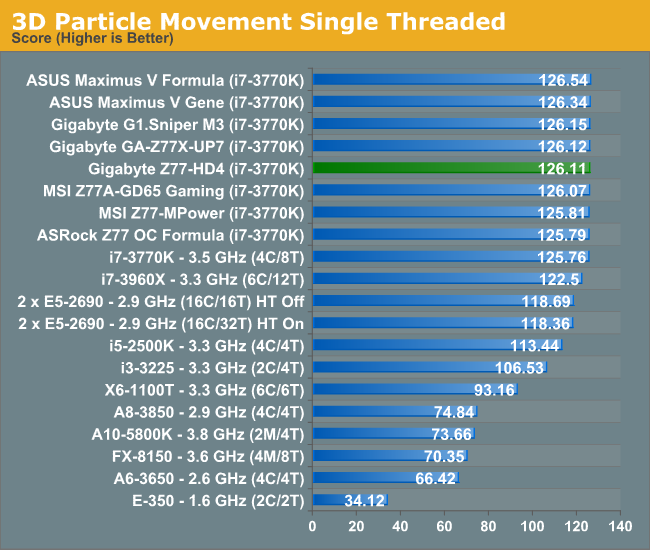
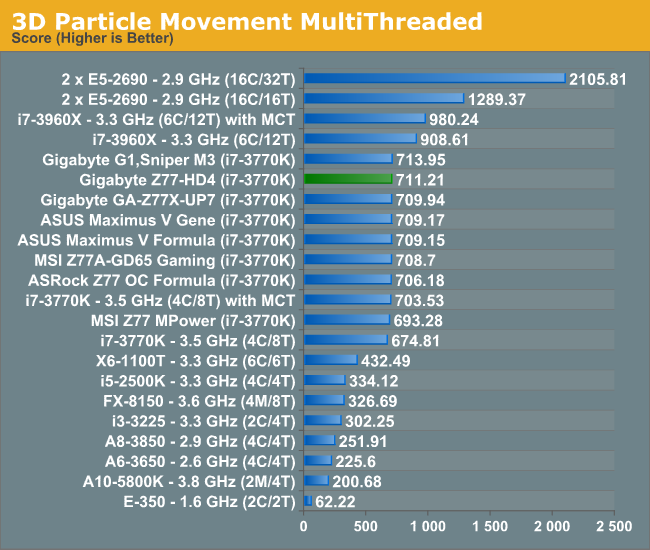
For a $120 motherboard, despite the DPC and Boot Time inefficiencies, the Z77-HD4 deals really well with our 3DPM benchmark, showcasing nice efficiency in multithreaded load. We do not test the memory here, so it provides a contrast result to the poor WinRAR performance below.
WinRAR x64 3.93 - link
With 64-bit WinRAR, we compress the set of files used in the USB speed tests. WinRAR x64 3.93 attempts to use multithreading when possible, and provides as a good test for when a system has variable threaded load. If a system has multiple speeds to invoke at different loading, the switching between those speeds will determine how well the system will do.
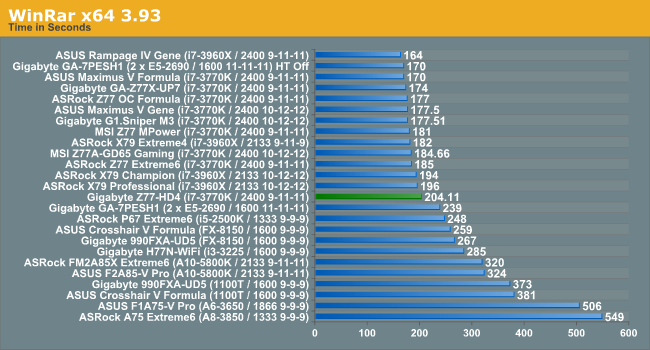
Despite the good 3DPM showing, the WinRAR score comes in as the worst 3770K+ at 2400 C9/C10 we have had. In contrast, for our new WinRAR 4.2 testing, the Z77-HD4 scored 54.36 seconds.
FastStone Image Viewer 4.2 - link
FastStone Image Viewer is a free piece of software I have been using for quite a few years now. It allows quick viewing of flat images, as well as resizing, changing color depth, adding simple text or simple filters. It also has a bulk image conversion tool, which we use here. The software currently operates only in single-thread mode, which should change in later versions of the software. For this test, we convert a series of 170 files, of various resolutions, dimensions and types (of a total size of 163MB), all to the .gif format of 640x480 dimensions.
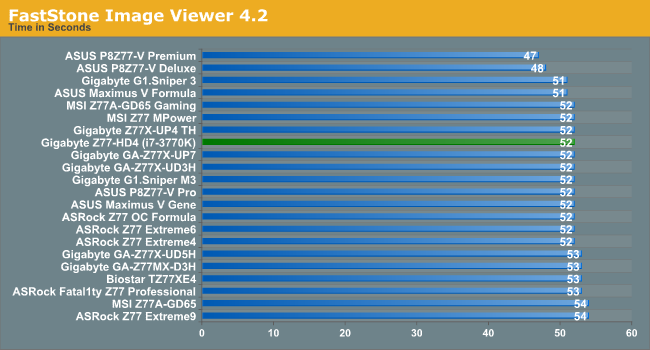
Xilisoft Video Converter
With XVC, users can convert any type of normal video to any compatible format for smartphones, tablets and other devices. By default, it uses all available threads on the system, and in the presence of appropriate graphics cards, can utilize CUDA for NVIDIA GPUs as well as AMD APP for AMD GPUs. For this test, we use a set of 32 HD videos, each lasting 30 seconds, and convert them from 1080p to an iPod H.264 video format using just the CPU. The time taken to convert these videos gives us our result.
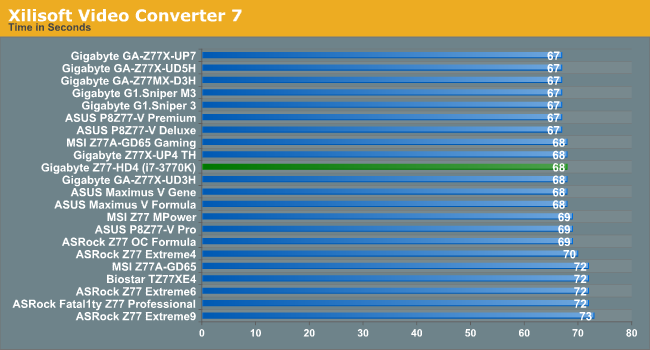
x264 HD Benchmark
The x264 HD Benchmark uses a common HD encoding tool to process an HD MPEG2 source at 1280x720 at 3963 Kbps. This test represents a standardized result which can be compared across other reviews, and is dependent on both CPU power and memory speed. The benchmark performs a 2-pass encode, and the results shown are the average of each pass performed four times.
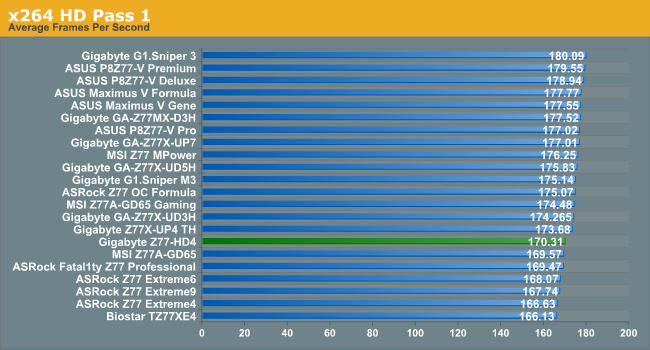
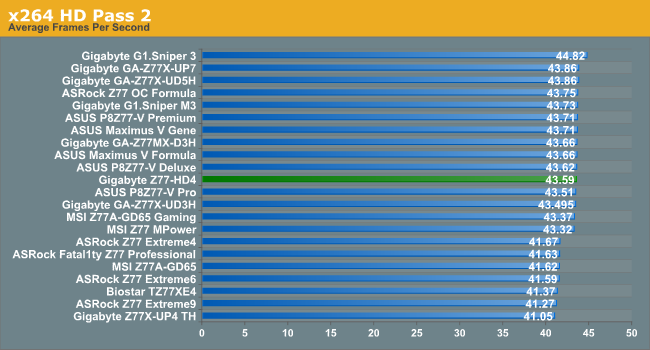










63 Comments
View All Comments
lmcd - Sunday, May 19, 2013 - link
I'm just going to tell you now that your assessment is completely off -- a good amount of people can tell the difference in regards to the audio. Plenty of people like the option to XF/SLI later in custom builds. And some of those performance differences were shocking. That was an audio demonstration, but could mouse polling face that, too?Anyway, don't get me started on the audio, but there is reason for better solutions than this board.
HardwareDufus - Monday, May 20, 2013 - link
the "this board is probably aimed at the internet café market in China" is pretty shameful and below the belt Ian..I agree as well... Don't be so elitest! It's refreshing to see a decent $120 motherboard that sacrifices nothing that 95% of buyers require. Ian you are getting spoiled reviewing too many high end motherboards jammed with features that only 2% of the buyers require. Come down out of the stratosphere and join the rest of us.
kmmatney - Monday, May 20, 2013 - link
I also think this comment was way off ""this board is probably aimed at the internet café market in China"If anything, the board is for this market:
http://www.microcenter.com/site/brands/intel-proce...
And its what I build for myself, friends, family, and all the computers I build for my company, and anyone else who wants a great gaming experience without breaking the bank.
Razorbak86 - Monday, May 20, 2013 - link
"Shameful" and "below the belt"? o.ODo you always get your panties in a twist over such innocuous opinions?
/seewhatididthere
kmmatney - Sunday, May 19, 2013 - link
I have to admit I never use the on-board buttons on my motherboard, and find beep codes to be just as useful as an error code display. At the end of the day, you still need to swap out parts to troubleshoot an error, regardless of an error code display.Flunk - Monday, May 20, 2013 - link
I agree with you I can't see a need for onboard power and reset switches on any motherboard. If the computer is set up they're worthless and if you're working on it you have your screwdriver right there to short out the front panel header. There really is no need at all for onboard power buttons.jabber - Monday, May 20, 2013 - link
I have to agree. I don't need dragons or ninjas on the box.I don't need heatsinks fashioned in some faux novelty bullet or landmine design.
I don't need LED lit BIOS reset buttons (I've used mine twice in 5 years, so no, not needed).
I don't need LED error notifications. I've had them and never needed them.
I don't need umpteen video out options, I have a GPU card.
I don't need built in audio, I have a sound card.
I don't need built in ethernet, I have a Intel CT nic.
I don't need a PS2 socket.
I don't need more then 4 SATA ports (three if I'm honest is all I ever need)
I don't need extra USB/Serial/Firewire expansion on the board.
I don't need glow in the dark sockets or custom motherboard colours.
I don't need 8 fan controller sockets.
What do I need? A good quality stripped down board that without all that unnecessary crud would probably cost $50. Unfortunately no one seems to think anyone wants such a board.
If most here were honest it's all they really need/want also.
Razorbak86 - Monday, May 20, 2013 - link
Good God, man, give it a rest. I hate it when someone starts ranting and then presumes to speak for the rest of us.jabber - Monday, May 20, 2013 - link
Sorry, I'll leave you to your motherboards and GPUs with dragons, neons and bullets on them.Was just stating that a lot of the features that motherboard manufacturers have loaded on 'as standard' are not really needed and only there to increase their slim profit margins.
After 20+ years of PC building I'm kind of fed up paying for crud I don't need in order to purchase a 'quality' board.
Why can't we have a good quality overclocking board without all the stuff we never use? Without all that stuff on there we could have much better signal paths, less noise and better power regs.
kmmatney - Monday, May 20, 2013 - link
That's a bit extreme. Most of us need/use the built in Network and Sound, and at least a DVI output is useful, even if you have a separate card. And practically everyone can use a lot of USB ports and headers.